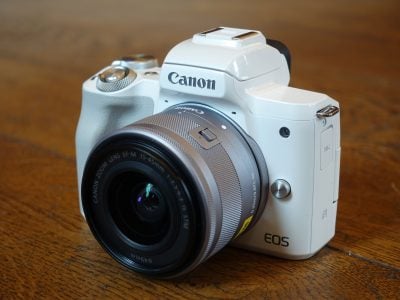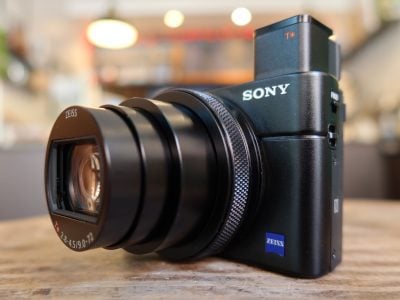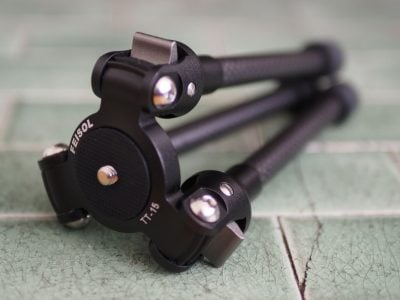Fujifilm FinePix S8000fd
-
-
Written by Gordon Laing
Fujifilm FinePix S8000fd design and controls
The Fujifilm FinePix S8000fd inherits the DSLR styling of its predecessors but like most super-zooms it’s much smaller than it looks. In the photo below we’ve placed it alongside Panasonic’s Lumix DMC-FZ18 and Canon’s ESO 400D / XTi, and it’s clear both super-zooms are dwarfed by the genuine DSLR.
While relatively compact though, it’s also clear from the photo above the S8000fd packs a surprisingly large grip. There’s plenty to wrap your fingers around, which coupled with a decent thumb rest and rubber coatings, makes it one of the most comfortable and secure super-zooms to hold. There’s also plenty of room between the grip and lens barrel to avoid any finger pinching, which some DSLRs aren’t immune from.
All in all, it’s a good design, although eagle-eyed camera enthusiasts may have a sense of déjà-vu. Not from an earlier Fujifilm camera, but the Olympus SP-550UZ / SP-560UZ. Take a look at the design page from our Olympus SP-550UZ review and you’ll see both cameras share the same basic physical shape, control layout and even the same specification lens. Both also employ 2.5in screens, sensor-shift stabilisation and are powered by AA batteries.
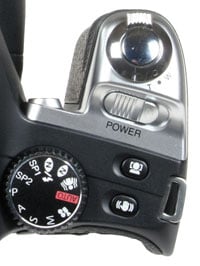 |
There are of course differences in the final design, not to mention sensor technology, image processor and menus, but it’s clear both models are based on the same chassis. We asked both Olympus and Fujifilm but neither admitted making cameras for each other, which suggests a third party design. Either way, the S8000fd (like its Olympus twins) is a well-built camera which is comfortable to hold and use.
The S8000fd’s top right surface is home to the shutter release, surrounded by a zoom rocker, a large sprung power switch, buttons to enable face detection and image stabilisation, and the main mode dial.
The dial features the usual Program, Aperture, Shutter priority and Manual modes along with full Auto, a movie mode and a handful of positions which may not be immediately obvious unless you’ve used a FinePix camera before. The N mode stands for Natural Light which as its name suggests, takes a photo at higher sensitivity without a flash. There’s also an alternative N mode with a flash symbol which takes two photos: one with natural light and a second with the flash just to make sure – although remember to warn your subjects they’ll be posing for two photos.
SP1 and SP2 allow you to select one of 13 scene presets through the on-screen menu system, each accompanied by a description and example photo. Of note, the web auction preset can combine up to four pictures as a single image, which can make it easy to quickly grab different poses of something you’re selling online.
The S8000fd offers full control over the aperture and shutter, with ten apertures to choose from with the lens zoomed-out, and 40 shutter speeds from 1/2000 to 4 seconds; sadly for fans of night photography, there’s no longer exposures available. Compare this with the Panasonic FZ18 which offers exposures up to 60 seconds.
When adjusting the S8000fd’s aperture, shutter or exposure compensation, a live histogram is shown on the left side of the screen. This also appears when using Program shift, but unlike other models doesn’t reveal itself as you cycle through the display options; we have a demonstration of this in our S8000fd video tour.
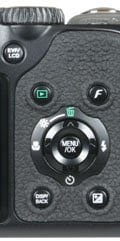 |
Round the back you’ll find the usual four-way joypad with a button in the middle to fire-up the menu or confirm options. Around this are four further buttons for Playback, Display mode, Face Detection and Fujifilm’s F-Mode menu – see below for more details.
Fujifilm FinePix S8000fd Screen and menus
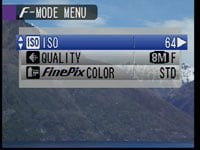 |
Fujifilm splits its options between the F-Mode menu and main menu system. The former is where you’ll get to change the ISO sensitivity, image quality and FinePix Colour mode, more of which on the next page.
Pressing the Menu button presents two pages of further options to adjust aspects including the metering mode, white balance, continuous shooting and AF mode, with a final option to enter the four Setup menus.
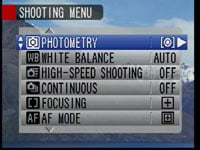 |
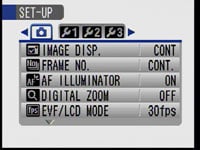 |
Fujifilm’s approach to menus and options is a little odd compared to rival cameras though. It’s great to have the F-Mode button offering instant access to common settings, but why limit it to just three items, when you could also include White Balance and perhaps the AF or metering modes.
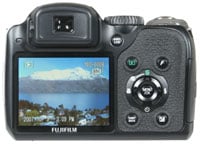 |
Fujifilm’s specifications describe the S8000fd as having a 2.7in screen, like the FinePix F50fd, but in reality our test model measured 2.5in. Despite the slightly smaller than quoted size though, the S8000fd’s screen is great quality, looking bright and detailed in use.
The S8000fd also includes options which include switching the refresh rate from 30 to 60fps, which may eat through your batteries quicker, but gives a smoother output. The screen can become washed-out under direct bright sunlight, but it’s easy to switch to the decent electronic viewfinder instead.
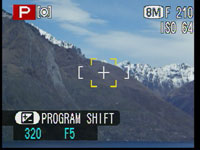 |
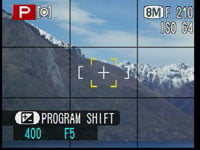 |
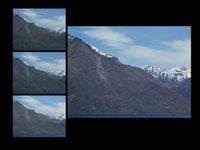 |
Pressing the DISP button cycles between four views during recording modes: one with shooting information, one that shows the image alone, a third which overlays a grid for help with alignment or applying the rule of thirds, and a fourth which shows a shrunken version of the live image alongside smaller thumbnails showing the last three images taken. As mentioned above, there’s no live histogram when cycling through the display options – to see one you’ll need to adjust the aperture, shutter or exposure compensation instead.
Fujifilm FinePix S8000fd Battery and connectivity
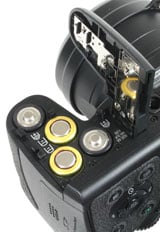 |
The Fujifilm FinePix S8000fd is powered by four AA batteries and supplied with a set of disposable Alkalines to get you started. While some prefer the easy accessibility of AA batteries, you’ll need to invest in a set of rechargeables and a charger if you don’t already own them.
Fujifilm reckons a good set of NiMH rechargeables should last you 500 shots, or 350 with Alkalines under CIPA conditions – we got about 150 from the supplied Alkalines before the battery meter started flashing, although we were using the image stabilisation and face detection almost throughout.
A door on the right side of the camera opens to reveal a dual-media slot which can accommodate either Fujifilm’s favoured xD or the more common and affordable SD memory cards. A flap on the left side hides a DC input for use with the optional AC-5VX adapter, along with a combined USB / TV output socket.
